After thearticle on Western Sicily it's time to talk about the other side of the island, the south-east coast. There South-eastern Sicily, with Taormina, Syracuse and Noto, is by far the most popular area of Sicily, and especially in recent years, one of the most popular in Italy, especially during the summer season. A trip to Eastern Sicily actually offers everything: cities of art that the whole world envies us, a beautiful sea, nature and, last but not least, incredible cuisine and the great sunshine and hospitality of the Sicilians. I have been there several times, but only last year I decided to follow an itinerary in Eastern Sicily and visit it in a more "systematic" way. The places that I will recommend you to visit you can see them in 1 week, but if you have more time you will not be bored! There are so many things to see and do in Eastern Sicily. The itinerary starts from Catania because most people (including me) will arrive in Sicily by plane, and the main airport of Eastern Sicily is Catania.

How to move in Eastern Sicily
The first fundamental thing to do when arriving in Sicily is to rent a car. It could certainly be more exciting to tour it by public transport as it is done in many countries of the world, but, unless you have several months available, you will have to give it up. Public transport (as well as infrastructure) are very few and in a very bad state. For the car rental I used the Rentalcars website and I collected and returned the car at Catania Airport. To avoid scams, however, remember to always check the votes and reviews that users give to the various car rental companies. You can find them on the Rentalcars website itself, but you can also double check on Trustpilot.
Eastern Sicily: what to see in 1 week
Catania and Etna
Our on-the-road itinerary for Eastern Sicily starts from Catania, the second largest city on the island after Palermo. Its historic center is full of magnificent baroque buildings, of monumental churches, of theaters (Roman and non-Roman) and markets and has one lively nightlife. In fact, Catania is a university city and welcomes many students from all over Sicily. The scenography in which it is inserted is very respectable, with Etna watching (or looming) to the north, and the link between the city and its volcano is evident; even the main street of the city bears his name (Via Etnea)! With its 3323 meters, Etna is the highest active terrestrial volcano in Euro-Asia and is visible from all of north-eastern Sicily. Being an active volcano it is not always possible to approach the main crater, but theexcursion on Etna it is certainly one of the most beautiful trips that can be done in Sicily. Find all the detailed information on Catania and the Etna excursion in the article "What to see in Catania and surroundings".
Where to sleep in Catania: B&B Palazzo Bruca
Find all the detailed information about Catania and the Etna excursion in the article "What to see in Catania and surroundings"

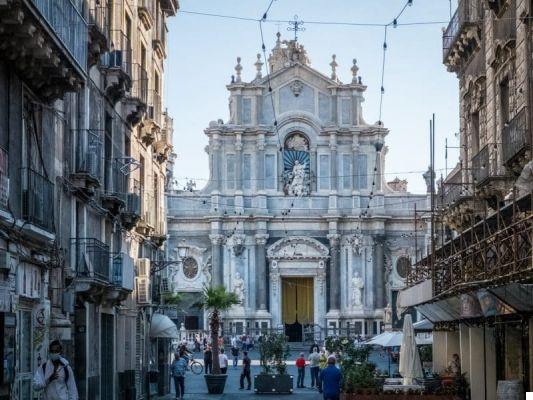

SIRACUSA
From Catania we continue our journey in South-Eastern Sicily stopping at SIRACUSA. Thanks to its position, with a natural harbor and access to trade routes in the Mediterranean, Syracuse imposed its dominion over the other cities of Sicily for more than 500 years. In the period of maximum flowering, the population was three times that of today and Syracuse was the major European power. This very important story is reflected in one large amount of monuments, ranging fromGreek, Roman and Medieval, Renaissance and Baroque periods. The beating heart of the city is the island of Ortigia, where there are several medieval and baroque stately homes, the Duomo, some remains of the Hellenistic period and the Maniace Castle on the tip. Everything is surrounded by the sea and there are also small beaches or respectable bathing areas. A curiosity, many scenes of the film were shot in Ortigia "Malena"By Tornatore.
What to see in Syracuse and surroundings
- Archaeological Park of Neapolis: the archaeological area of Syracuse is located on the mainland, slightly inland, and contained most of the social and religious structures of the ancient Greek-Roman city: theaters, altars and sanctuaries. Inside the park you cannot miss the famous Greek Theater, the ruins of the Roman amphitheater and the Ear of Dionysus. Ticket 10 euros.
- Catacombs of the Basilica of S. Giovanni: this is a place that I found particularly fascinating I must say. We are talking about the ruins of the ancient cathedral of Syracuse, under which there are very large catacombs, a labyrinth of corridors in which Christians and St. Marciano, bishop of the city, were buried. To visit them you need to participate in a guided tour (highly recommended! They leave every 30 '- the cost is 8 euros). They are located on the mainland, outside Ortigia.
- Temple of Apollo: you will see it as soon as you cross the bridge that separates Ortigia from the mainland. There are the remains of a huge Doric temple (XNUMXth century), whose magnificence can be understood.
- Cathedral of Syracuse: this site was already consecrated when the Greeks began to build the temple of Athena in 530 BC The latter was then transformed into a Christian church in 640 AD. The interior is baroque, but quite sober.
- Hypogeum of Piazza Duomo: it is not always open, but if you find it open, enter (5 euros)! The entrance is next to the Duomo, a series of underground tunnels and ancient cisterns that were used by Syracusans as an anti-aircraft shelter during World War II.
- Arethusa source: this spring near the sea was already mentioned by the oracle of Delphi and led the first Greek colonists to Syracuse. The legends about this source are many and, with papyri, ducks and fish, it is a must in Ortigia (also one of the most photographed!).
- Maniace Castle: a defensive bulwark built by Frederick II in 1239, located on the tip of Ortigia (ticket for 4 euros).
- Pantalica Natural Reserve: If you have time it is worth visiting this natural reserve which is 40 km from Syracuse. Here there is the largest necropolis in Sicily, inside a deep gorge of the Anapo River. It is a declared extraordinary place UNESCO World Heritage Site. To fully appreciate it, I recommend that you participate in a guided tour.
Where sleeping in Syracuse: Ortigia House
You may be interested in this TOUR: to the Pantalica Nature Reserve


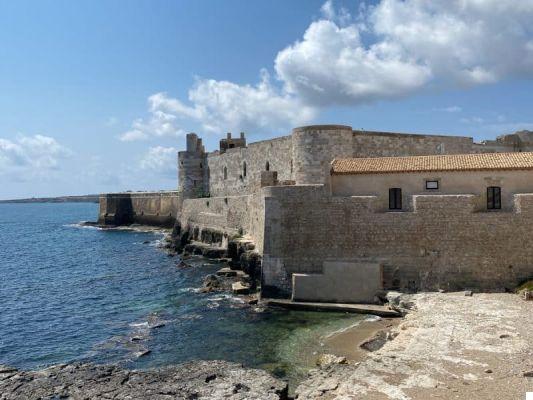
Noto and the Vendicari Oasis
A stop not to be missed on an itinerary in Eastern Sicily is definitely Noto, the center of the homonymous valley. Noto has one of the most beautiful historic centers in Sicily and in recent years (perhaps also thanks to the marriage of the Ferragnez) it has become one of the most popular destinations on the island. Completely destroyed by the 1693 earthquake (like most of the cities of eastern Sicily), Noto was rebuilt in record time and the result is truly splendid! The greatest architects and designers of the golden age of Sicilian Baroque worked on its reconstruction (like Rosario Gagliardi for example, who also designed the beautiful churches of Modica and Ragusa) and its historic center has splendid palaces and incredible churches.
If you are interested in nature and maybe you want to do some sea I suggest you go about 10 km south of Noto, where there is theOasis of Vendicari. This nature reserve is made up of swamps, lagoons, dunes and salt flats and inside it also includes several beaches (not equipped, you have to bring everything!) such as the Calamosche beach, That of San Lorenzo or that of vendicari (which is located next to the old tonnara .. without roof but very impressive!). To better appreciate it, I recommend this guided trekking. Find all the detailed info on Noto and its surroundings in this article (including the excursion to the Vendicari Oasis).
Where to sleep in Noto: A Calata B&B
Find all the detailed info on Noto and its surroundings in this article (including the excursion to the Vendicari Oasis).



Marzamemi and Ispica
From Noto we then descend towards the sea to reach Marzamemi, one of the most photographed places in the area, especially its square square. We are talking about a small village with an old tonnara renowned, still today, for tuna-based dishes (you can buy it from Campisi, the most famous producer in Sicily). The square of the tonnara has been renovated and is full of bars and restaurants, some of which also overlook the sea (such as "La Cialoma" for example). Come for lunch or at sunset for an aperitif by the sea (in 1h you will have seen everything anyway!). Proceeding from Marzamemi towards Modica it is then worth making a stop in the small town of ispica, both to see the beautiful Sinatra loggia in front of the Basilica of Santa Maria Maggiore, which the cave dwellings in the Cava d'Ispica gorge. This gorge is 13 km long and you can also reach it on foot starting from Ispica or from the northern section, in Cava d'Ispica Nord, more towards Modica. From the latter entrance there is a panoramic path that descends into the gorge through which you then enter the catacombs and rock tombs. The peculiarity of the square of the Sinatra loggia is instead its unique elliptical shape.



Modica and Scicli
I think I can say it with serenity, Modica it is, without a shadow of a doubt, the place that I liked and that amazed me the most of my itinerary in Eastern Sicily. I stayed for two nights and I wish I could have stayed even longer! I loved its being developed on multiple hills (there is in fact one Modica Alta it's a Modica Bassa, from which you can enjoy fantastic views), its great late Baroque heritage, the incredible food of its restaurants, the chocolate, the terraces and its night views. Modica also seemed to me a very lively city (unlike Ragusa for example), small but full of bars and restaurants frequented by the locals; a city certainly organized for tourists but not only. I have dedicated a full article “What to see in Modica and surroundings". Among the things to see around Modica there is certainly also the picturesque village of Scicli. If you have seen the series of Montalbano on TV you will have a certain deja vù because the Town Hall of Scicli appears in all the episodes as the police station. The Town Hall opens up Via Mormorina Penna, the most scenic street of Scicli on which the most important and beautiful buildings of the town are located. Not far away there is Palazzo Beneventano, the Baroque masterpiece of Scicli, adorned with monsters deformed by grotesque grins. Climbing the steps that start right next to it you then reach the abandoned church of San Matteo from which you can enjoy a beautiful view of the city. THE Montalbano fans surely they can evaluate this tour on the places of the TV series, where you visit all the locations of the film (the tour starts from Syracuse).
Where sleeping in Modica: Le Magnolie Hotel
Find all the detailed info on Modica and its surroundings in this article



Ragusa and Punta Secca
Another must for any itinerary in Eastern Sicily is Ragusa, more exactly Ragusa Ibla, the ancient city. Destroyed by the earthquake of 1693, this part of the city was initially abandoned and a new one was built, Ragusa (or Upper Ragusa). The inhabitants of Ragusa Ibla, however, slowly rebuilt it, maintaining its old medieval layout made up of narrow streets that climb the rocky spur and this part of the city was reunited with the new one. To be honest it reminded me a lot of Matera, especially the views of Ragusa Ibla that open from Santa Maria della Scala in Ragusa Superiore. The central square of Ragusa Ibla is very beautiful, it is sloping, and hosts the church of San Giorgio, but it is worth wandering through the alleys of the whole town to fully appreciate it. Then move to Ragusa Superiore to get the "postcard" views of Ragusa Ibla.
If you take this trip in the summer and you also want to do some sea around Ragusa I recommend you to go to oa Punta Secca and Sampieri. Punta Secca is a small seaside village with the beach where the Montalbano's house (the one on the beach, in Marinella) in the TV drama. Here I recommend that you go there in the afternoon and stay to see the sunset as there are a couple of bars that have incredible views. Sampieri it is another characteristic village with a beautiful beach and some equipped lido. If you love industrial archeology do not miss the ruins of the old one Furnace Pen, which can also be seen from the beach (also here they shot some scenes of Montalbano ..).
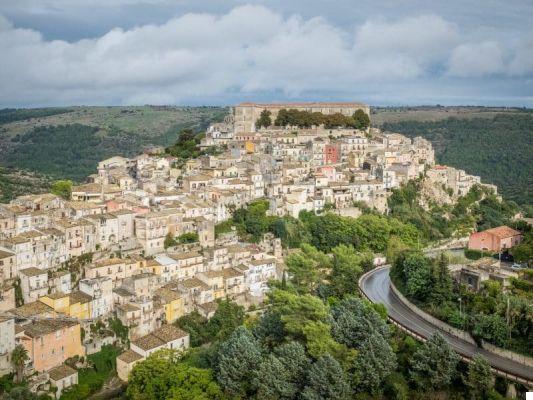
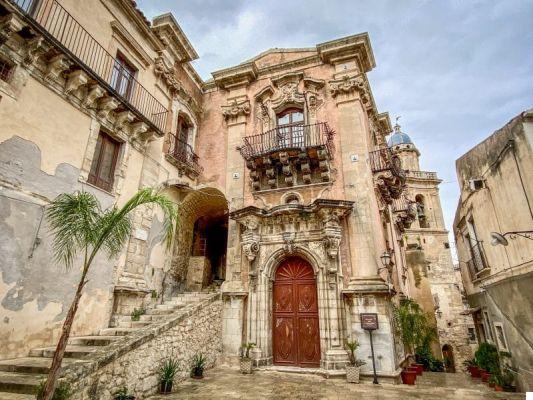

Agrigento and Favara
One cannot hide behind a finger, one comes to Agrigento just to visit the Valley of the Temples, and I would say that this visit is also the focus of all trips to Eastern Sicily. What remains ofancient Akragas represents the the most fascinating Greek ruins in Sicily and all of Italy; Akragas was one of the richest and most powerful cities in Sicily and it is easy to understand by seeing the extent, quality and quantity of the temples that are found only in the sacred area (which corresponds precisely to the current Valley of the Temples). One of the things that fascinated me the most, in addition to the objective beauty of the temples, is the fact that this area was populated and used for several centuries both before and after the Greek period and the necropolises bear witness to this. medieval that are found along the whole via Sacra. The most impressive temple is undoubtedly the Temple of Concord, the most intact, located in the Eastern area. Dating back to 430 BC, it is located in the middle of the sacred way and is the symbol of the Valley of the Temples. Next to it there is also a beautiful one bronze sculpture of Mitoraj, the Fallen Icarus. Also in Agrigento and its surroundings I have dedicated an entire article ("What to see in Agrigento and surroundings") where you will find all the practical information to visit the Valley of the Temples, Favara and the Scala dei Turchi.
Lovers of art and street art cannot miss the Farm Cultural Park of Favara, at the gates of Agrigento. We are talking about an artistic project born in 2010 from the personal need of Florinda and Andrea to raise their daughters in a stimulating and creative context, and it develops mainly in 7 communicating courtyards in the center of Favara. The intent is to slowly recover the entire historic center of Favara and transform the town into the second tourist attraction in the province of Agrigento after the Valley of the Temples. Today some renovated buildings that are located between these 7 courtyards house shows and exhibitions (both permanent and temporary) and many artists have come here to contribute to the cause. The cultural center is very nice and interesting and inside it also includes a bar, a pizzeria and a hostel.
Where to sleep in Agrigento: The Terraces of Pirandello:
Find all the detailed info on Agrigento, Favara and surroundings in this article



Taormina
This itinerary in Eastern Sicily ends in Taormina, as the last stage of rapprochement with Catania. Taormina is the most famous and refined holiday resort in Sicily, and has been loved by writers, artists and celebrities for decades. It is an expensive and exclusive location and, unfortunately, it has lost a lot of its authenticity, especially in the historic center, now full of tourist-catching shops. That said, it remains a very beautiful town thanks to its enviable geographical position and its monuments. Even the beaches, which are actually located at the foot of the mountain (not too close), are very beautiful. As for logistics, you will have to leave your car in one of the multi-storey car parks along the access road and then walk (some have a free shuttle to reach the center). But what are the things not to be missed in Taormina?
What to see in Taormina
- Greek Theatre: the main attraction of the city and one of the unmissable monuments on a trip to Sicily. Dug into the hill, this well-preserved Greek (later Roman) theater enjoys a magnificent natural setting, with a view that sweeps from the Sicilian coast, to the Calabrian coast, to the summit of Etna.
- Covaja Palace: built by the Arabs as a defense tower in the XNUMXth century, today it houses the Sicilian Museum of Popular Arts and Traditions.
- Square IX April: the "balcony of Taormina", with a breathtaking view of the coast. Watch out for the prices of the bars if you want to sit down to enjoy the view!
- Cuseni House: house-museum that works as a charming air bnb. The building and its historic garden were designed by Frank Brangwyn and come complete with 13 viewing terraces, 7 fountains and rare plants.The villa's interiors are decorated with works by Picasso, Henry Faulkner and other 11th century masters. The list of famous guests includes philosopher Bertrand Russell, novelist Roald Dahl, and actress Greta Garbo. It is possible to visit it by participating in a guided tour (at 00:16 in English, at 00:XNUMX in Spanish).
- Castello Saraceno: if you love walking you can reach, above Taormina, the Madonna della Rocca with the ruins of the medieval Castello Saraceno. The view from here is amazing and at sunset it is even more so.
Where sleeping in Taormina: B&B La Terrazza sul Mare

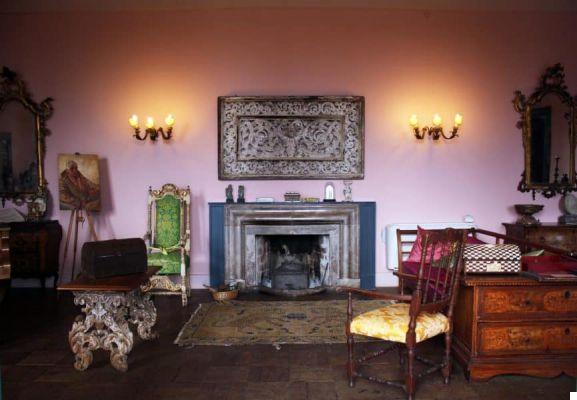

7-day itinerary in Eastern Sicily
- Day 1: Catania
- Day 2: Syracuse
- Day 3: the valley of Noto and Marzamemi
- Day 4: Modica and Scicli
- Day 5: Ragusa and Punta Secca
- Day 6: Agrigento and Favara
- Day 7: Taormina and return to Catania
Itinerary in Eastern Sicily of 10 or more days
- Day 1: Catania
- Day 2: Etna
- Day 3: Syracuse
- Day 4: the valley of Noto and Marzamemi
- Day 5: Modica and Scicli
- Day 6: Ragusa and Punta Secca
- Day 7: Caltagirone and Piazza Armerina
- Day 8: Agrigento and Favara
- Day 9: Taormina and Acireale
- Day 10: Alcantara Gorges and return to Catania

You might also be interested in these other articles I wrote about Sicily:
- What to see in Catania and surroundings
- What to see in Modica and surroundings
- What to see in Agrigento and surroundings
- Western Sicily: 3 days between Marsala, Mazara, Selinunte, Segesta and Gibellina
- What to see in Palermo in 3 days
- What to see around Palermo
- Where to eat in Palermo
- Favignana: the beaches, where to sleep and where to eat
- Marettimo: how to reach it, what to see and where to sleep
- Levanzo: how to reach it, what to see and where to sleep
- 10 beautiful farmhouses with swimming pool in Sicily


























